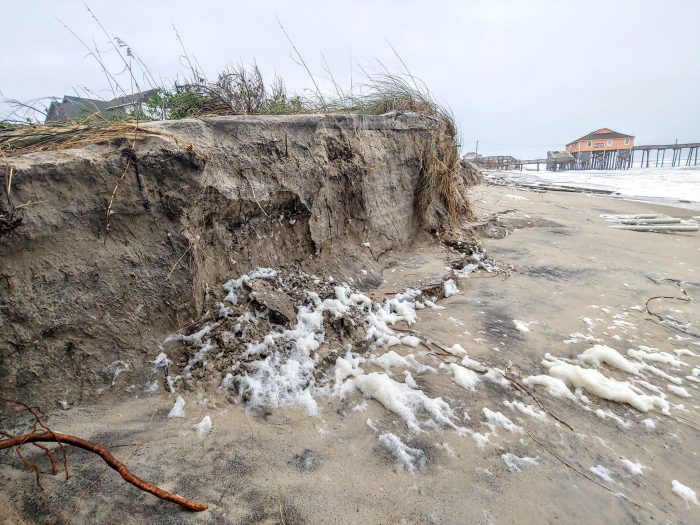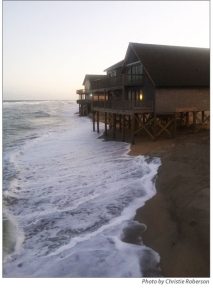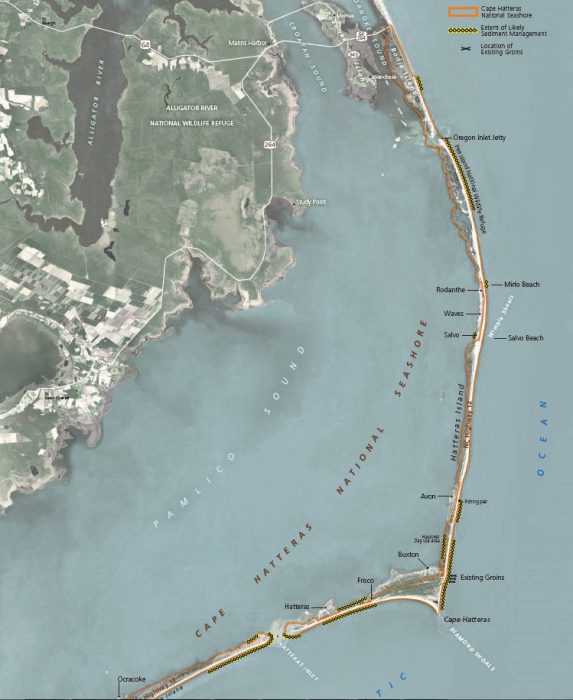
Monday marked the first installment of four webinars hosted by the National Park Service (NPS) to discuss the creation of a 20-year sediment management framework for the Cape Hatteras National Seashore (CHNS), and to solicit the public’s feedback on the endeavor.
Natural accretion and erosion processes have impacted the Hatteras and Ocracoke island shorelines for decades due to anthropogenic activities, (like dune building, dune planting, inlet dredging, and dune maintenance), as well as other factors, like sea level rise.
As such, sediment management efforts have been utilized along the shoreline to control erosion and stabilize sand dunes for decades, from active dune building in the 1930s-1960s, to recent beach nourishment projects in the last few years.

Since the 1970s, localized beach nourishment has been the primary method of combating shoreline erosion, but so far, it has been restricted to Ocracoke Island, the Buxton area, and Rodanthe. In some places, segments of the beach are relatively stable, and natural processes maintain a line of strong sand dunes. In other hot spots on the islands, however, erosion of the shoreline has resulted in the semi-regular overwash of N.C. Highway 12, as well as adjacent communities.
So in order to provide a faster way to address these erosion-related project requests, the National Park Service first published a Notice of Intent in the Federal Register on April 10 to prepare an Environmental Impact Statement (EIS) for sediment management within the National Seashore.
The purpose of the EIS is to develop a streamlined framework for implementing sediment management projects, which includes the method, location, and frequency for sediment management actions that may be permitted over the next 20 years.
CHNS has received various requests, (and anticipate future requests), to issue special use permits for protecting roads and bridges, repairing island damages, and restoring habitats through the placement of dredged materials along eroded sections of the barrier islands.
A formal sediment management framework will allow the NPS to provide timely responses for localized beach nourishment requests, and is needed to assist CHNS to address these current and future project proposals.
“I cannot comment on the state or federal permitting process, but typically, if a hypothetical project proposal came to us, we would create a stand-alone EIS, and that [process] would take 6 to 12 months,” said CHNS Superintendent Dave Hallac at Monday’s webinar. “In the future, from a Park Service standpoint, those projects could be permitted easily… The ability to permit these projects would be greatly enhanced, and the timeframe [to do so] would be reduced.”
The webinars that are being hosted this week are part of the first stage in the roughly 12-month process to develop the sediment management framework.
Spring 2020 marks the start of the public scoping process, and from this input, the NPS will develop a draft EIS in the summer of 2020. The draft will be released to the public in the fall of 2020 for additional comments, and a final EIS will be released for public review in the winter of 2021 before a final decision is made.
During Monday’s webinar, two preliminary alternatives were outlined that were developed by the NPS, and which are relative to requests to issue special use permits to varying agencies, including the North Carolina Department of Transportation (NCDOT), Dare and Hyde counties, and the U.S. Army Corps of Engineers (USACE).
“These alternatives are preliminary alternatives – our first crack at proposed action, or no action,” said Hallac. “A full range of alternatives will be presented in the draft of the EIS, which will hopefully be available this fall.”
The two basic alternatives that were presented on Monday are as follows:
- Alternative A: No-Action – The NPS would not permit sediment management activities at the National Seashore over the next two decades. The no-action alternative would preclude CHNS partners, such as the NCDOT, from implementing sediment management to protect N.C. Highway 12 outside of its existing easement, and Dare County to perform beach nourishment projects along the National Seashore.
- Alternative B: Proposed Action – The NPS could permit other agencies and municipalities to conduct, with conditions, sediment management in the form of:
- Beach Nourishment
- Habitat Restoration
- Dune reconstruction and enhancement
- Emergency breach fill

Depending on when the final EIS is approved and recorded, it could potentially impact projects that are currently in the works, which includes a Buxton beach nourishment maintenance project slated for 2021 and 2022, and a potential Avon beach nourishment project in the future.
“This project is meant to provide a framework to potentially permit sediment management projects for the next 20 years,” said Hallac. “If this process is completed before the Buxton project is in place, it could serve as the [guidelines] for the beach nourishment.”
The public is encouraged to attend the webinars on Tuesday, Wednesday, and Thursday to provide their feedback and to learn more about the project, and / or to submit their comments before the public scoping period ends on May 10.
How to Comment
Comments can be submitted electronically at https://parkplanning.nps.gov/CAHASediment, which is the preferred method.
Comments can also be mailed or hand-delivered to “Cape Hatteras Sediment Management EIS Superintendent, Cape Hatteras National Seashore, 1401 National Park Drive, Manteo, NC 27954
Upcoming Webinars
Monday’s webinar, which included a public comment period, will also be repeated on the following dates and times:
- Public Scoping Webinar 2:
- April 21, 7:00 – 8:00 PM ET
- Link: https://attendee.gotowebinar.com/register/8685229670379605517
- Webinar ID: 788-190-091
- Public Scoping Webinar 3:
- April 22, 6:00 – 7:00 PM ET
- Link: https://attendee.gotowebinar.com/register/3125413884600066573
- Webinar ID: 627-583-883
- Public Scoping Webinar 4:
- April 23, 5:30 – 6:30 PM ET
- Link: https://attendee.gotowebinar.com/register/1589959090394535435
- Webinar ID: 546-626-443
For more information on the project, visit https://parkplanning.nps.gov/projectHome.cfm?projectID=94076.



